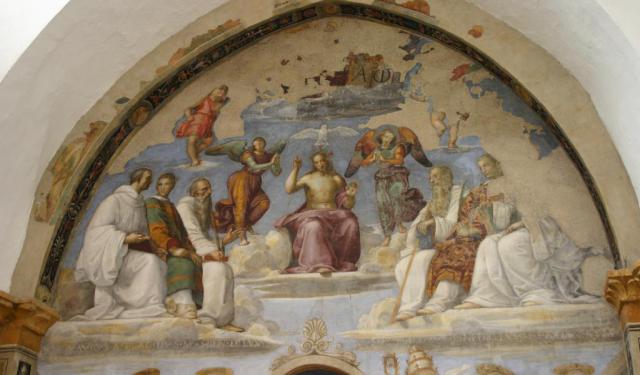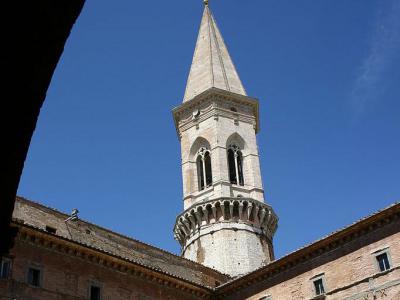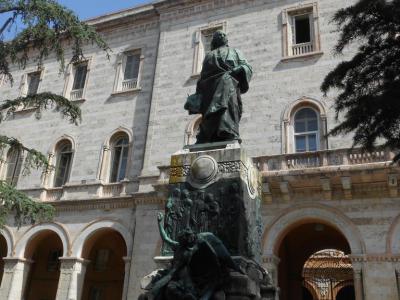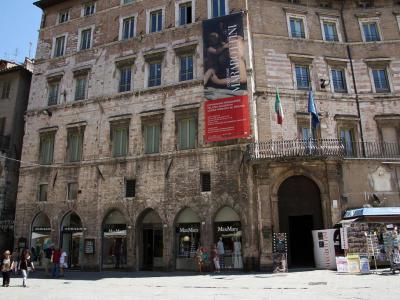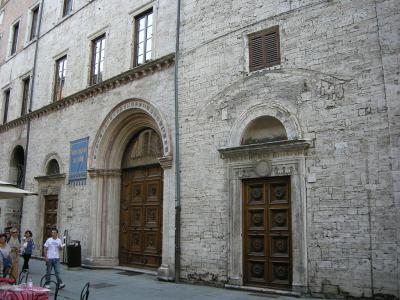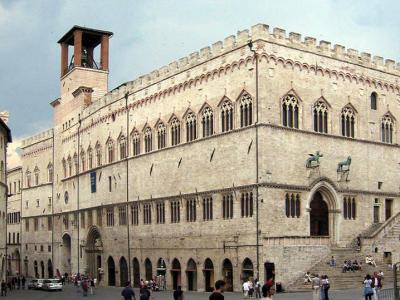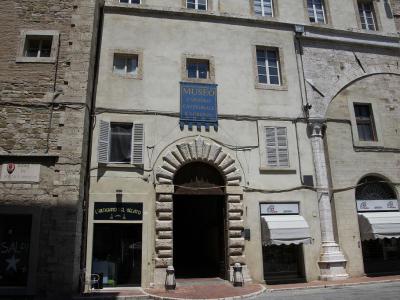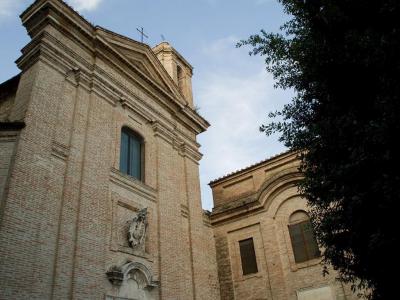Perugino and Renaissance Art Walk (Self Guided), Perugia
Perugia today is a well-known cultural and artistic center in Italy that regularly plays host to a multitude of annual festivals and events. The most glorious period in the history of the city, from an artistic standpoint, lasted from the 13th to the 16th centuries.
Perugia’s most celebrated artist, Pietro Vannucci (1450–1523), better known as “il Perugino”, nicknamed so after his hometown, is one of the foremost masters and key protagonists of the renewal of Italian art during the early Renaissance. He is also famous as Raphael's teacher.
The Basilica di San Pietro in Perugia, part of the eponymous Catholic abbey, is a treasure trove of frescoes and paintings by Perugino and his grand student. From here, make way to Corso Vannucci, the main artery of the historic center and one of Italy’s top destinations for people-watching – packed all day long with tourists and locals alike.
The outset of Corso Vannucci is marked by the Perugino Monument. Further down the street you will find the Baldeschi al Corso Palace, the medieval residence now turned into a museum. Practically a stone's throw away from it is the Nobile Collegio Del Cambio (the Noble College of the Money Changers' Guild) whose hall is adorned with frescoes by Perugino, depicting a mix of Roman deities and Christian imagery, reflecting the humanist learning of that period.
The nearby Palazzo dei Priori, presently home to the Galleria Nazionale dell’Umbria (the National Gallery of Umbria), holds an important collection of Renaissance art, one of the finest in Italy. Also, most visitors to the city can't help noticing the preponderance of a spectacular Renaissance building in the heart of the city - the Cattedrale di San Lorenzo (Cathedral of San Lorenzo).
To acquaint yourself more closely with these and other monuments of the Renaissance era in Perugia, take this our self-guided walking tour and discover a wealth of art in one of Italy's most beautiful places!
Perugia’s most celebrated artist, Pietro Vannucci (1450–1523), better known as “il Perugino”, nicknamed so after his hometown, is one of the foremost masters and key protagonists of the renewal of Italian art during the early Renaissance. He is also famous as Raphael's teacher.
The Basilica di San Pietro in Perugia, part of the eponymous Catholic abbey, is a treasure trove of frescoes and paintings by Perugino and his grand student. From here, make way to Corso Vannucci, the main artery of the historic center and one of Italy’s top destinations for people-watching – packed all day long with tourists and locals alike.
The outset of Corso Vannucci is marked by the Perugino Monument. Further down the street you will find the Baldeschi al Corso Palace, the medieval residence now turned into a museum. Practically a stone's throw away from it is the Nobile Collegio Del Cambio (the Noble College of the Money Changers' Guild) whose hall is adorned with frescoes by Perugino, depicting a mix of Roman deities and Christian imagery, reflecting the humanist learning of that period.
The nearby Palazzo dei Priori, presently home to the Galleria Nazionale dell’Umbria (the National Gallery of Umbria), holds an important collection of Renaissance art, one of the finest in Italy. Also, most visitors to the city can't help noticing the preponderance of a spectacular Renaissance building in the heart of the city - the Cattedrale di San Lorenzo (Cathedral of San Lorenzo).
To acquaint yourself more closely with these and other monuments of the Renaissance era in Perugia, take this our self-guided walking tour and discover a wealth of art in one of Italy's most beautiful places!
How it works: Download the app "GPSmyCity: Walks in 1K+ Cities" from Apple App Store or Google Play Store to your mobile phone or tablet. The app turns your mobile device into a personal tour guide and its built-in GPS navigation functions guide you from one tour stop to next. The app works offline, so no data plan is needed when traveling abroad.
Perugino and Renaissance Art Walk Map
Guide Name: Perugino and Renaissance Art Walk
Guide Location: Italy » Perugia (See other walking tours in Perugia)
Guide Type: Self-guided Walking Tour (Sightseeing)
# of Attractions: 8
Tour Duration: 1 Hour(s)
Travel Distance: 2.3 Km or 1.4 Miles
Author: leticia
Sight(s) Featured in This Guide:
Guide Location: Italy » Perugia (See other walking tours in Perugia)
Guide Type: Self-guided Walking Tour (Sightseeing)
# of Attractions: 8
Tour Duration: 1 Hour(s)
Travel Distance: 2.3 Km or 1.4 Miles
Author: leticia
Sight(s) Featured in This Guide:
- Basilica di San Pietro (Saint Peter's Basilica and Abbey)
- Monument of Pietro Vannucci "Perugino"
- Palazzo Baldeschi al Corso (Baldeschi al Corso Palace)
- Nobile Collegio Del Cambio (Noble College of the Money Changers' Guild)
- National Gallery of Umbria
- Capitular Museum
- Cattedrale di San Lorenzo (Saint Lawrence's Cathedral)
- Cappella di San Severo (Chapel of San Severo)
1) Basilica di San Pietro (Saint Peter's Basilica and Abbey) (must see)
The basilica di San Pietro in Perugia is a part of the eponymous Catholic abbey, established in 996 by abbot Pietro Vincioli, later canonized as Saint Peter. The basilica stands on the foundations of a previous cathedral that was reportedly built as early as the 4th century AD for the first bishopric of Perugia. The land beneath it had been sacred to the pagan Etruscans and Romans for many centuries prior to that.
The Abbey coexisted peacefully with the people of Perugia until 1398 when the locals burned it down after the abbot, Francesco Guidalotti, had arranged the killing of a leader of the Raspanti Party. Most of the Perugians held membership in this party and so, quite naturally, they got furious. Following the death of the last monk of San Pietro, in 1899, the property of the Abbey was taken over by the Department of Agricultural, Food and Environmental Sciences of the University of Perugia.
Inside the main court is a 13th-century polygonal clock tower. Romanesque blind arches on the façade of the basilica are a product of later restoration. The interior, akin to an early Christian temple, features the Gothic choir, made of wood, dating back to the 16th century, and the triple-arched portal, designed by Galeazzo Alessi in 1571.
The sacristy, added in 1451, carries a great deal of frescoes and paintings by the likes of Perugino, Parmigianino and Raphael. Among the ones by Perugino there are five smaller paintings depicting Santa Scholastica, Santa Ercolano, Santa Constantino, Santa Pietro Abbate, Santa Mauro and Santa Placido. In the right aisle, above the door leading to Saint Joseph's Chapel, there are three more 17th-century copies from Perugino made by Giovanni Battista Salvi, aka Sassoferrato. Also, in the left aisle, at the Sacramento Chapel, you can find the Pietà, the late work by Perugino, where the painter portrays himself in the face of Giuseppe di Arimatea.
The Abbey coexisted peacefully with the people of Perugia until 1398 when the locals burned it down after the abbot, Francesco Guidalotti, had arranged the killing of a leader of the Raspanti Party. Most of the Perugians held membership in this party and so, quite naturally, they got furious. Following the death of the last monk of San Pietro, in 1899, the property of the Abbey was taken over by the Department of Agricultural, Food and Environmental Sciences of the University of Perugia.
Inside the main court is a 13th-century polygonal clock tower. Romanesque blind arches on the façade of the basilica are a product of later restoration. The interior, akin to an early Christian temple, features the Gothic choir, made of wood, dating back to the 16th century, and the triple-arched portal, designed by Galeazzo Alessi in 1571.
The sacristy, added in 1451, carries a great deal of frescoes and paintings by the likes of Perugino, Parmigianino and Raphael. Among the ones by Perugino there are five smaller paintings depicting Santa Scholastica, Santa Ercolano, Santa Constantino, Santa Pietro Abbate, Santa Mauro and Santa Placido. In the right aisle, above the door leading to Saint Joseph's Chapel, there are three more 17th-century copies from Perugino made by Giovanni Battista Salvi, aka Sassoferrato. Also, in the left aisle, at the Sacramento Chapel, you can find the Pietà, the late work by Perugino, where the painter portrays himself in the face of Giuseppe di Arimatea.
2) Monument of Pietro Vannucci "Perugino"
The monument of Pietro Vannucci in Perugia was created by the Italian sculptor Todi Enrico Quattrini.
The sculptural complex conceived by Quattrini features an all-round figure of the great master in the likeness of his self-portrait in the Collegio del Cambio. In his left hand the artist holds the end of his “robone” (ceremonial dress) wrapped around his figure; in his right hand he holds a bundle of spread sheets, on one of which appears to be the fine sketch of a Virgin drawn in a typical Perugian style.
The statue stands on a high cubic marble base covered with four bronze bas-relief panels depicting some episodes from the life of Perugino and his greatest pupil, Raphael. At the base of the monument, the agile silhouette of a winged genius of vivid naturalism painting holds a palette and a brush lightly raised in the direction of the overhanging Vannucci figure.
The bronze parts for the monument were cast at the Albanesi foundry in Rome. The statue was solemnly unveiled on 23 September 1923 in the presence of Prince Emanuele Filiberto of Savoy Aosta.
The original location for the sculpture – outside the Turreno Theater – was picked in 1907 by a designated group of artists. However, it took the monument another sixteen years to be inaugurated, first in Piazza Sant'Isidoro (later known as Piazza della Repubblica), and then, in 1940, moved to the center of the Carducci Gardens, where it stands today.
The sculptural complex conceived by Quattrini features an all-round figure of the great master in the likeness of his self-portrait in the Collegio del Cambio. In his left hand the artist holds the end of his “robone” (ceremonial dress) wrapped around his figure; in his right hand he holds a bundle of spread sheets, on one of which appears to be the fine sketch of a Virgin drawn in a typical Perugian style.
The statue stands on a high cubic marble base covered with four bronze bas-relief panels depicting some episodes from the life of Perugino and his greatest pupil, Raphael. At the base of the monument, the agile silhouette of a winged genius of vivid naturalism painting holds a palette and a brush lightly raised in the direction of the overhanging Vannucci figure.
The bronze parts for the monument were cast at the Albanesi foundry in Rome. The statue was solemnly unveiled on 23 September 1923 in the presence of Prince Emanuele Filiberto of Savoy Aosta.
The original location for the sculpture – outside the Turreno Theater – was picked in 1907 by a designated group of artists. However, it took the monument another sixteen years to be inaugurated, first in Piazza Sant'Isidoro (later known as Piazza della Repubblica), and then, in 1940, moved to the center of the Carducci Gardens, where it stands today.
3) Palazzo Baldeschi al Corso (Baldeschi al Corso Palace)
Palazzo Baldeschi al Corso is the former residence of Baldo degli Ubaldi, the famous 14th-century Italian lawman, who, in 1369, decided to split from his brothers, and for that purpose had enlarged his existing dwelling by merging it with neighboring properties – in Corso Vannucci, Via Danzetta, Via Baldo, Via dello Struzzo and Via Baglioni.
Further additions to the building were made in 1480 and 1489-96, and then in the 1870s when the Baldeschi family modified it further. The latter was done in a bid to bring the medieval appearance in line with more modern trends. The result was a gradual transformation into a homogeneous structure, akin to a palace. It was at that time that the travertine portal – onto the Corso street – had appeared along with the identical travertine windows, spanning the entire length of the building and contributing to its overall unitary aspect.
In 2002 the palace was acquired by the Cassa di Risparmio di Perugia Foundation, and is now home to their outstanding art collection, featuring, among others, 147 extraordinary pieces of Renaissance Majolica (ceramics) – originally from the Sprovieri Collection of Poggio Mirteto, near Rieti, and the Frizzi Baccioni collection of Scarperia, near Florence.
The main floor is used for temporary exhibits, while the second floor is given to the Marabottini Collection – a donation of over 700 paintings, sculptures, drawings, engravings, miniatures, waxes, glasses, ivories, porcelains and furnishings, all dated between the 16th and 20th centuries.
The third and the fourth floors of the palazzo, after careful restoration and refurbishment, have been hosting the Foundation’s own collection of artworks: more than 200 pieces, spanning the 15th to 19th centuries, by renowned masters like Perugino, Pinturicchio, Signorelli, Matteo da Gualdo and Niccolò di Liberatore, known as l’Alunno.
Further additions to the building were made in 1480 and 1489-96, and then in the 1870s when the Baldeschi family modified it further. The latter was done in a bid to bring the medieval appearance in line with more modern trends. The result was a gradual transformation into a homogeneous structure, akin to a palace. It was at that time that the travertine portal – onto the Corso street – had appeared along with the identical travertine windows, spanning the entire length of the building and contributing to its overall unitary aspect.
In 2002 the palace was acquired by the Cassa di Risparmio di Perugia Foundation, and is now home to their outstanding art collection, featuring, among others, 147 extraordinary pieces of Renaissance Majolica (ceramics) – originally from the Sprovieri Collection of Poggio Mirteto, near Rieti, and the Frizzi Baccioni collection of Scarperia, near Florence.
The main floor is used for temporary exhibits, while the second floor is given to the Marabottini Collection – a donation of over 700 paintings, sculptures, drawings, engravings, miniatures, waxes, glasses, ivories, porcelains and furnishings, all dated between the 16th and 20th centuries.
The third and the fourth floors of the palazzo, after careful restoration and refurbishment, have been hosting the Foundation’s own collection of artworks: more than 200 pieces, spanning the 15th to 19th centuries, by renowned masters like Perugino, Pinturicchio, Signorelli, Matteo da Gualdo and Niccolò di Liberatore, known as l’Alunno.
4) Nobile Collegio Del Cambio (Noble College of the Money Changers' Guild)
The Noble College of the Money Changers' Guild (Nobile Collegio del Cambio) in Perugia is a masterwork of art, architecture, and history, serving as the historic seat of the Money Changers' Guild (Arte del Cambio). Established between 1452 and 1457, this headquarters was part of the Palace of Priors (Palazzo dei Priori) on Corso Vannucci, one of Perugia's most iconic landmarks. The Guild's emblem-a griffin perched above a coffer-still adorns the building, symbolizing its enduring legacy.
The College's architectural design was crafted by Bartolomeo di Mattiolo and Lodovico di Antonibo, with the latter also designing its magnificent main door. This door, carved by Antonio da Mercatello in 1501, exemplifies Renaissance craftsmanship. The wooden furnishings, attributed to Domenico del Tasso, are decorated with grotesque motifs, marking the first known use of such decoration in furniture.
The Audience Hall (Sala delle Adienze), the centerpiece of the College, was brought to life through the artistry of Pietro Perugino, one of the greatest painters of the Italian Renaissance. The frescoed lunettes in this hall depict allegorical and biblical scenes, showcasing Perugino's mastery in creating vibrant, harmonious compositions.
The College Chapel of San Giovanni Battista, constructed between 1506 and 1509, is another highlight. Its frescoes, painted by Giannicola di Paolo, a pupil of Perugino, were completed between 1515 and 1518. The chapel's ceiling portrays the Eternal Father surrounded by apostles, evangelists, and saints, while the altar features a Baptism of Christ and an Annunciation flanking it. The abundant use of gold and lapis lazuli in the chapel’s decoration compensates for the absence of windows, infusing the space with light and vibrancy.
The Noble College of the Money Changers' Guild houses over 550 coin weights, offering a glimpse into Perugia’s banking history from the 15th to 19th centuries. Far more than a display of wealth, the Collegio del Cambio blends artistry and function, showcasing Renaissance Perugia’s cultural and historical significance.
The College's architectural design was crafted by Bartolomeo di Mattiolo and Lodovico di Antonibo, with the latter also designing its magnificent main door. This door, carved by Antonio da Mercatello in 1501, exemplifies Renaissance craftsmanship. The wooden furnishings, attributed to Domenico del Tasso, are decorated with grotesque motifs, marking the first known use of such decoration in furniture.
The Audience Hall (Sala delle Adienze), the centerpiece of the College, was brought to life through the artistry of Pietro Perugino, one of the greatest painters of the Italian Renaissance. The frescoed lunettes in this hall depict allegorical and biblical scenes, showcasing Perugino's mastery in creating vibrant, harmonious compositions.
The College Chapel of San Giovanni Battista, constructed between 1506 and 1509, is another highlight. Its frescoes, painted by Giannicola di Paolo, a pupil of Perugino, were completed between 1515 and 1518. The chapel's ceiling portrays the Eternal Father surrounded by apostles, evangelists, and saints, while the altar features a Baptism of Christ and an Annunciation flanking it. The abundant use of gold and lapis lazuli in the chapel’s decoration compensates for the absence of windows, infusing the space with light and vibrancy.
The Noble College of the Money Changers' Guild houses over 550 coin weights, offering a glimpse into Perugia’s banking history from the 15th to 19th centuries. Far more than a display of wealth, the Collegio del Cambio blends artistry and function, showcasing Renaissance Perugia’s cultural and historical significance.
5) National Gallery of Umbria (must see)
The National Gallery of Umbria is one of Italy’s premier art collections, showcasing masterpieces from the Middle Ages to the Renaissance, with a strong focus on the Umbrian School of Painting. It is housed on the upper floors of the Priori Palace (Palazzo dei Priori), a striking example of Gothic civil architecture that has served as Perugia’s municipal seat since medieval times. The museum spans 4,000 square meters across two floors, with 40 exhibition rooms dedicated to the permanent collection and additional space for rotating temporary exhibitions.
The origins of the collection date back to the mid-16th century, with the foundation of the Perugian Academy of Drawing (Accademia del Disegno), initially housed at the Olivetan Convent in Montemorcino. Over the centuries, political upheavals, including the Napoleonic suppression of religious houses and the later unification of Italy, brought many artworks into state ownership. By 1863, the collection was formally named after Pietro Vannucci, better known as Perugino, but only found a permanent home in the Palazzo dei Priori in 1878. Renamed the National Gallery of Umbria in 1918, it underwent its most recent renovation in 2006, creating a modern visitor experience.
The gallery’s collection is arranged chronologically and highlights key figures of Italian art. Particular emphasis is placed on Umbrian masters such as Benedetto Bonfigli, Fiorenzo di Lorenzo, Perugino, Pintoricchio, and their followers, providing a deep dive into the regional artistic heritage.
The National Gallery of Umbria remains a cultural treasure, blending Perugia’s historical legacy with its extraordinary artistic heritage, making it a must-visit for art enthusiasts and history lovers alike.
The origins of the collection date back to the mid-16th century, with the foundation of the Perugian Academy of Drawing (Accademia del Disegno), initially housed at the Olivetan Convent in Montemorcino. Over the centuries, political upheavals, including the Napoleonic suppression of religious houses and the later unification of Italy, brought many artworks into state ownership. By 1863, the collection was formally named after Pietro Vannucci, better known as Perugino, but only found a permanent home in the Palazzo dei Priori in 1878. Renamed the National Gallery of Umbria in 1918, it underwent its most recent renovation in 2006, creating a modern visitor experience.
The gallery’s collection is arranged chronologically and highlights key figures of Italian art. Particular emphasis is placed on Umbrian masters such as Benedetto Bonfigli, Fiorenzo di Lorenzo, Perugino, Pintoricchio, and their followers, providing a deep dive into the regional artistic heritage.
The National Gallery of Umbria remains a cultural treasure, blending Perugia’s historical legacy with its extraordinary artistic heritage, making it a must-visit for art enthusiasts and history lovers alike.
6) Capitular Museum
The Museo dell'Opera del Duomo, better known as the Capitular Museum of San Lorenzo (Museo del Capitolo della Cattedrale di San Lorenzo), is adjacent to the Cathedral of San Lorenzo. The museum was commissioned by the Chapter of the Cathedral (hence the name "Capitolare") and is located in one of its outbuildings: 25 rooms adjacent to the cloister, next to the Cathedral, on the ground floor and below, inside the crypt.
The first exposition here was opened in 1923. In the 1980s the museum was closed for archaeological excavations, during which some underground rooms were discovered. The museum was reopened in 2000, and today preserves many unique artifacts, the best known of which is the altarpiece Pala di Sant'Onofrio by Luca Signorelli.
The exhibited items date from the early Middle Ages through the 19th century. Among them are the paintings, sculptures, and rare manuscripts from the 6th to the 17th centuries, as well as ecclesiastic furnishings. Here you can also see the works of artists from the school of Perugino and the Umbrian Renaissance, including Benedetto Bonfigli, Bartolomeo Caporali and others.
The first exposition here was opened in 1923. In the 1980s the museum was closed for archaeological excavations, during which some underground rooms were discovered. The museum was reopened in 2000, and today preserves many unique artifacts, the best known of which is the altarpiece Pala di Sant'Onofrio by Luca Signorelli.
The exhibited items date from the early Middle Ages through the 19th century. Among them are the paintings, sculptures, and rare manuscripts from the 6th to the 17th centuries, as well as ecclesiastic furnishings. Here you can also see the works of artists from the school of Perugino and the Umbrian Renaissance, including Benedetto Bonfigli, Bartolomeo Caporali and others.
7) Cattedrale di San Lorenzo (Saint Lawrence's Cathedral) (must see)
Saint Lawrence’s Cathedral, or the Metropolitan Cathedral of Saint Lawrence, is a prominent Roman Catholic cathedral in Perugia. Dedicated to Saint Lawrence, it has served as the archiepiscopal seat of the Archdiocese of Perugia-Città della Pieve since 1986. With a history stretching back to the bishopric's establishment, the cathedral's current structure was designed by Fra Bevignate in 1300, initiated in 1345, and completed in 1490. Its façade, adorned with an unfinished white and pink marble lozenge design, reflects a project partially inspired by Arezzo Cathedral.
Unlike traditional layouts, the cathedral's flank faces the bustling IV Novembre Square. The Braccio Loggia, a Renaissance addition by Fioravante Fioravanti, adds architectural charm, while remnants of the old Roman wall and the "Justice Stone" from 1234 echo Perugia's layered history. A statue of Pope Julius III by Vincenzo Danti stands here, commemorating his local contributions.
The cathedral’s interior is a striking Church Hall concept, with a nave and two aisles of equal height spanning 68 meters. The Holy Ring Chapel houses the revered relic of the Virgin Mary’s wedding ring, accompanied by intricate Renaissance reliquaries. Highlights include the apse’s wooden choir by Giuliano da Maiano and Domenico del Tasso, the Sacrament Chapel featuring Cesare Nebbia's Pentecost, and the Baptistery Chapel with its Renaissance marble perspective.
The cathedral's artistic centerpiece is Federico Barocci’s Deposition from the Cross in the Chapel of Saint Bernardino. Other notable elements include frescoes by Gian Antonio Pandolfi in the sacristy and a museum showcasing works by Meo da Siena, Andrea Vanni, and Luca Signorelli. Manuscripts from the 10th century and Renaissance sculptures enrich the cathedral's cultural heritage.
With its blend of historical significance, artistic treasures, and architectural elegance, Saint Lawrence’s Cathedral remains a symbol of Perugia's religious and cultural identity.
Unlike traditional layouts, the cathedral's flank faces the bustling IV Novembre Square. The Braccio Loggia, a Renaissance addition by Fioravante Fioravanti, adds architectural charm, while remnants of the old Roman wall and the "Justice Stone" from 1234 echo Perugia's layered history. A statue of Pope Julius III by Vincenzo Danti stands here, commemorating his local contributions.
The cathedral’s interior is a striking Church Hall concept, with a nave and two aisles of equal height spanning 68 meters. The Holy Ring Chapel houses the revered relic of the Virgin Mary’s wedding ring, accompanied by intricate Renaissance reliquaries. Highlights include the apse’s wooden choir by Giuliano da Maiano and Domenico del Tasso, the Sacrament Chapel featuring Cesare Nebbia's Pentecost, and the Baptistery Chapel with its Renaissance marble perspective.
The cathedral's artistic centerpiece is Federico Barocci’s Deposition from the Cross in the Chapel of Saint Bernardino. Other notable elements include frescoes by Gian Antonio Pandolfi in the sacristy and a museum showcasing works by Meo da Siena, Andrea Vanni, and Luca Signorelli. Manuscripts from the 10th century and Renaissance sculptures enrich the cathedral's cultural heritage.
With its blend of historical significance, artistic treasures, and architectural elegance, Saint Lawrence’s Cathedral remains a symbol of Perugia's religious and cultural identity.
8) Cappella di San Severo (Chapel of San Severo)
The Chapel of San Severo, located in Perugia, is a fascinating part of the Camaldolese convent complex adjacent to the Church of San Severo. Today, it functions as a small museum showcasing a remarkable fresco titled The Trinity and Saints (175x389 cm), a collaborative masterpiece by Raphael and Perugino, with work spanning from 1505–1508 (Raphael) to 1521 (Perugino).
Originally part of the left nave of a fifteenth-century church, the chapel now comprises a single room adjacent to the eighteenth-century structure. It is integrated into Perugia’s museum system and is managed by the Regional Directorate for Cultural and Landscape Heritage of Umbria.
The fresco, set in a pointed chapel niche, is divided into two parts. The upper section, by Raphael, portrays the Trinity with Benedictine and Camaldolese saints identified by golden inscriptions. Christ sits on a cloud throne, flanked by angels, with the Holy Spirit as a dove above. This work marks Raphael's shift to a monumental style, influenced by the Umbrian school and Fra Bartolomeo, hinting at his later masterpieces like the Disputation of the Sacrament. The lower section, finished by Perugino after Raphael died in 1520, depicts saints like Scholastica, Jerome, and John the Evangelist. While framed by a parapet, these figures lack the depth of Raphael’s style, reflecting Perugino’s older, fifteenth-century approach.
The fresco was commissioned by Troilo Baglioni, a former bishop of Perugia, and Cardinal Gabriele de' Gabrielli di Gubbio, bishop of Urbino. While the date of 1505 appears on the fresco, some scholars suggest it marks the start of the work, completed later as Raphael’s style evolved toward greater monumentality. Raphael only completed the upper part before relocating to Rome, leaving Perugino to finish the lower section in a nostalgic yet somewhat static style.
The fresco has endured over the centuries, though parts of it, including the Eternal, Saint John, and an angel, have been lost, possibly due to imperfect restorations. The work’s grandeur was praised by Vasari, who highlighted Raphael’s prominent signature.
A central niche within the chapel also houses a Madonna and Child in polychrome terracotta, a fine example of late fifteenth-century Tuscan craftsmanship, adding further charm to this compact yet historically and artistically rich space.
Originally part of the left nave of a fifteenth-century church, the chapel now comprises a single room adjacent to the eighteenth-century structure. It is integrated into Perugia’s museum system and is managed by the Regional Directorate for Cultural and Landscape Heritage of Umbria.
The fresco, set in a pointed chapel niche, is divided into two parts. The upper section, by Raphael, portrays the Trinity with Benedictine and Camaldolese saints identified by golden inscriptions. Christ sits on a cloud throne, flanked by angels, with the Holy Spirit as a dove above. This work marks Raphael's shift to a monumental style, influenced by the Umbrian school and Fra Bartolomeo, hinting at his later masterpieces like the Disputation of the Sacrament. The lower section, finished by Perugino after Raphael died in 1520, depicts saints like Scholastica, Jerome, and John the Evangelist. While framed by a parapet, these figures lack the depth of Raphael’s style, reflecting Perugino’s older, fifteenth-century approach.
The fresco was commissioned by Troilo Baglioni, a former bishop of Perugia, and Cardinal Gabriele de' Gabrielli di Gubbio, bishop of Urbino. While the date of 1505 appears on the fresco, some scholars suggest it marks the start of the work, completed later as Raphael’s style evolved toward greater monumentality. Raphael only completed the upper part before relocating to Rome, leaving Perugino to finish the lower section in a nostalgic yet somewhat static style.
The fresco has endured over the centuries, though parts of it, including the Eternal, Saint John, and an angel, have been lost, possibly due to imperfect restorations. The work’s grandeur was praised by Vasari, who highlighted Raphael’s prominent signature.
A central niche within the chapel also houses a Madonna and Child in polychrome terracotta, a fine example of late fifteenth-century Tuscan craftsmanship, adding further charm to this compact yet historically and artistically rich space.
Walking Tours in Perugia, Italy
Create Your Own Walk in Perugia
Creating your own self-guided walk in Perugia is easy and fun. Choose the city attractions that you want to see and a walk route map will be created just for you. You can even set your hotel as the start point of the walk.
Perugia Introduction Walking Tour
Perugia was one of the twelve foremost cities of the Etruscan Federation. It was mentioned by Quintus Fabius Pictor, a Roman historian. He tells of a military expedition of Fabius Maximus Rullianus against the Etruscan League and Perugia in 309 BC.
By 216 BC, Perugia had seen the light and allied itself with Rome in the Second Punic War against Carthage. Things went swimmingly until 41 BC.... view more
Tour Duration: 2 Hour(s)
Travel Distance: 2.1 Km or 1.3 Miles
By 216 BC, Perugia had seen the light and allied itself with Rome in the Second Punic War against Carthage. Things went swimmingly until 41 BC.... view more
Tour Duration: 2 Hour(s)
Travel Distance: 2.1 Km or 1.3 Miles
The Most Popular Cities
/ view all
